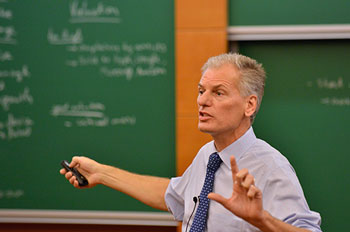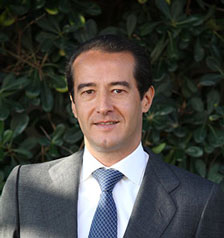If you want to advance your career as a globally focused professional, the IESE Global Executive MBA program is for you. Through a rigorous curriculum, participants become better strategists, leaders and decision makers. They learn from world-class faculty and diverse classmates who enrich the classroom experience in Europe, Asia, and North and South America. We interviewed Academic Director Govert Vroom and Admissions Director Nico Van den Brink for more insights.
What is the typical profile of a GEMBA participant?
 Govert Vroom: GEMBA participants generally have 10 to 15 years of work experience, with much of that time dedicated to leadership and managerial roles. We also have people who are owners or managers of their own companies. Everybody who comes here is in some sense looking for a transformation; they want to change their careers.
Govert Vroom: GEMBA participants generally have 10 to 15 years of work experience, with much of that time dedicated to leadership and managerial roles. We also have people who are owners or managers of their own companies. Everybody who comes here is in some sense looking for a transformation; they want to change their careers.
How is the program structured?
Nico Van den Brink: It’s a modular program that allows people to combine an international career with their MBA. There are six modules with five courses in each module. The program is taught across the world: you take modules in New York, Barcelona, Sao Paulo and Shanghai, among other locations. You will be on campus for two weeks every two months.
Vroom: But there is continuity: when you’re not on campus you are still in touch with your teammates, fellow students and faculty through online sessions and simulation, or simply through email and Google Docs. The learning takes place not just through professors, but also through discussions among students.
Everybody is there to learn and they are willing to contribute. The intensity of the program sparks a sharing of ideas and a platform where students continuously challenge each other.
Van den Brink: Participants come from around the world. They are accustomed to working across time zones to deliver assignments. The beauty of the course is that it goes beyond theory. Instead of learning about how to do business in China from a classroom in New York, you go to a classroom in China and visit Chinese companies. You can do the same in Europe, in the U.S., and potentially in Latin America, Africa or Southeast Asia if you take electives there.
How does the GEMBA put blended learning into practice?
Van den Brink: We were the first program to have blended learning, which is a seamless combination of in-person and distance learning. It allows people to continue their professional life while they learn. We keep looking at new technologies and ways of transmitting learning, yet at the same time, strongly believe in the value of face-to-face discussion. Technology is just the enabler.
Vroom: It’s not about using 3D presentations or holograms, it’s about making the discussions we have — whether in-person or virtual — the most valuable, informed, challenging and insightful they can be.
What learning methodologies does the program use?
 Van den Brink: We rely heavily on the case method, which addresses a real business problem in a class discussion. Instead of focusing just on the theory, case studies require students to take a decision on a real business problem. And by discussing that problem with senior people from different functional and geographical backgrounds, they get a deeper understanding of the problem — from multiple perspectives.
Van den Brink: We rely heavily on the case method, which addresses a real business problem in a class discussion. Instead of focusing just on the theory, case studies require students to take a decision on a real business problem. And by discussing that problem with senior people from different functional and geographical backgrounds, they get a deeper understanding of the problem — from multiple perspectives.
Vroom: It’s action-based learning. During the program, participants create a business plan and individually complete a final, in-company project. In self-formed groups of three to five members, students select a company to work with — their own company or it could be a startup — and develop a challenge and a solution to that challenge.
Van den Brink: This is where the whole course comes together. It’s a real-life consulting project. The students are brought in as external consultants and present their projects before the management team and GEMBA professors. It has to be supported by the faculty and relevant both academically and to the company. The students apply everything they have learned throughout the MBA. In many cases, one of the students works in that particular company, in which case it offers them a unique platform to advance their careers. It’s a good way of rounding off the MBA since it brings everything they’ve learned into practice.
What makes the GEMBA at IESE stand out?
Van den Brink: What makes IESE truly stand out is its humanistic views. People are at the center of what we do. Companies are made of people. If you just look at the technical part and forget about the people, you won’t be able to execute. Class sizes are small, everybody knows each other. The professors know the students by name and know what everybody’s background is. The whole experience is about each individual student. Also, the program is based on our mission and values — we believe you can be a good professional and a good person at the same time. That’s what makes IESE students stand out as leaders — an ethical focus.
What relationships do students have with each other and the school once they graduate?
Van den Brink: Because the MBA is so intense, you become part of one big family. The professors are truly interested in the students. It’s very common to contact a professor out of the blue 10 years after the program and they will remember you. They’ll make time to meet for a quick discussion to give you tips or put you in contact with somebody. These relationships among alumni and professors are long-lasting and truly special.


